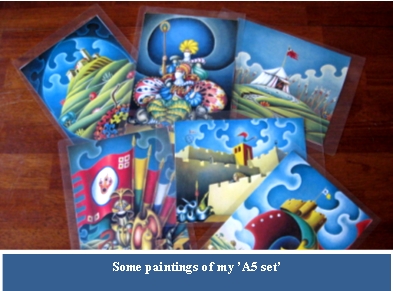
Pilgrims, the Ultimate Choice
Zsuzsa Lindner, Hungary
Zsuzsa Lindner works as a practising teacher in Szabó Lőrinc Hungarian and English Dual Language Primary and Secondary School in Budapest, Hungary. She has worked as a mentor of English language teacher trainees. She has been involved in a materials development project. She has been the member of the committee of IATEFL Hungary since January 2008 and committee member and project coordinator of the working group dealing with disadvantaged youth for 6 years at Útilapu Hálózat, the Hungarian Branch of Service Civil International, an international peace organisation dealing with peace education and organising voluntary workcamps. E-mail:lindnerzsuzsa@hotmail.com
What comes to your mind when hearing the words: teachers and summer? Close your eyes and think about it - what was the first word that you thought of? Was it holiday? No school? No students? No colleagues? I bet, something along those lines. But there are many teachers who had thought of different words, who had planned a different kind of summer. Those who were enthusiastic and lucky enough to get the chance to take part in a summer teacher training course could choose from lots of courses in Europe and some also had the opportunity to win a grant for a Comenius Professional Development Course within the Life-long Learning Programme of the European Commission. This is exactly what I did in the summer of ’09 and it proved to be one of the best decisions of my career.
I’ve been to such courses before and I always had a great time and learnt a lot, but Pilgrims in Canterbury really stands out for many reasons. In this article I’m going to share with you my thoughts and feelings about the course I took part in: Teaching Advanced Students in July 2009, taught by Hania Kryszewska.
My motto ever since
 On one of the last days in Canterbury I went into a classroom where I hadn’t been before and there were lots of quotations on the walls all around. There was a bright yellow poster which really caught my attention and which I had to read a few times to really understand it. It said: ’If you always do what you’ve always done - you always get what you’ve always got.’ It sounds simple, doesn’t it? Still, I needed some time to really see how it is connected to my life and why it had a stronger effect on me than any of the other quotations. I think I got the answer: after having been teaching for 10 years I developed many routines and got used to doing things in this or that way all the time. Some of these routines still work well, but others don’t. Some of them can be used in all classes, some can’t and many of them seem to fail from time to time, more and more often, to be frank. Methods/ideas that worked perfectly well 5 years ago, don’t seem to be working any more. Have the students changed? Have I changed? It would be easier to say that I’m just as good as before and the students have changed, but it would be a lie. The truth is that I have a lot less time and energy for preparing my classes and thinking about what to do and how to do it than in the first few years of my career. This is totally normal, but it seems that now is the time to put (some of) my routines aside, start using different methods and become as active and enthusiastic about designing tasks and experimenting with new ideas/methods as I used to be as a beginner teacher. I cannot afford to be lazy and stick to old routines, because if I do, I will soon ’fail’so often, that I will not be enjoying teaching any more. I think the quotation above really sums it up for me: if I want things to change, I need to change them, or at least become part of the change. On one of the last days in Canterbury I went into a classroom where I hadn’t been before and there were lots of quotations on the walls all around. There was a bright yellow poster which really caught my attention and which I had to read a few times to really understand it. It said: ’If you always do what you’ve always done - you always get what you’ve always got.’ It sounds simple, doesn’t it? Still, I needed some time to really see how it is connected to my life and why it had a stronger effect on me than any of the other quotations. I think I got the answer: after having been teaching for 10 years I developed many routines and got used to doing things in this or that way all the time. Some of these routines still work well, but others don’t. Some of them can be used in all classes, some can’t and many of them seem to fail from time to time, more and more often, to be frank. Methods/ideas that worked perfectly well 5 years ago, don’t seem to be working any more. Have the students changed? Have I changed? It would be easier to say that I’m just as good as before and the students have changed, but it would be a lie. The truth is that I have a lot less time and energy for preparing my classes and thinking about what to do and how to do it than in the first few years of my career. This is totally normal, but it seems that now is the time to put (some of) my routines aside, start using different methods and become as active and enthusiastic about designing tasks and experimenting with new ideas/methods as I used to be as a beginner teacher. I cannot afford to be lazy and stick to old routines, because if I do, I will soon ’fail’so often, that I will not be enjoying teaching any more. I think the quotation above really sums it up for me: if I want things to change, I need to change them, or at least become part of the change.
Our group
One of the reasons why this was the best course ever is our group. Six Polish, six Spanish, a Czech, a German, a Swiss, a Turkish, an Austrian and a Hungarian (that’s me) – turned out to be the perfect mix for a perfect course. According to Alicia Ávila Losada, one of the Spanish participants, it was like a ’friends' gathering who enjoyed a common interest in the English language’. I couldn’t agree more and this is why I decided to include quotations by some of my groupmates in this article.
We were very lucky, because our group was as homogenous as it possibly can be. Even though we were of different backgrounds, from different age groups, teaching in very different settings, but somehow we still felt that we were ’learning with and from other people, very similarly tuned, more or less at the same level of understanding, motivation and orientation’ (Ivana Pekarova, Czech Republic) So there was this fotunate make-up of the group, plus Hania made sure that for the different tasks we always changed partners and the group was mixed all the time, which resulted in everyone getting along with everyone well and working together effectively. This, I believe, laid down the foundations of a successful course.
The course content
 Teaching a language is always challenging, no matter what age group or level you are teaching. I’ve taught students from beginner level to advanced and I find it more difficult to teach advanced learners, because they have already seen ’everything’. What I mean by this is that they have already learnt all the grammar points, they have already practised vocabulary items connected to ’hundreds’ of topics, they are able to read, write and speak English, at least theoretically. But even if their English is not yet at advanced level, many students- especially teenagers- may believe that they have it all and they don’t need to work hard any more to get better. Teaching a language is always challenging, no matter what age group or level you are teaching. I’ve taught students from beginner level to advanced and I find it more difficult to teach advanced learners, because they have already seen ’everything’. What I mean by this is that they have already learnt all the grammar points, they have already practised vocabulary items connected to ’hundreds’ of topics, they are able to read, write and speak English, at least theoretically. But even if their English is not yet at advanced level, many students- especially teenagers- may believe that they have it all and they don’t need to work hard any more to get better.
I remember teaching 8 year-olds. I was teaching the colours by using coloured pencils and some games. That sparkle in the eyes of those children as they all wanted to come to the board and play with those pencils, as if they were something more than coloured pieces of wood. This is what I don’t seem to be achieving with my 17-18 year-old upper-intermediate to advanced learners, and this is why I felt I needed to take part in a course designed especially for this level: to get new ideas, to learn new approaches, to learn new tricks that may put that sparkle in my teenage students’eyes, too.
And I’m happy to say that by the end of the two weeks, ’Hania's course had definetely widened my methodological approach’(Gabi Scheel, Germany) , it has given me new perspectives and new ways to look at my job. I’m more open to experiment with new methods, new ideas. I regained my confidence and motivation to start integrating technology into my teaching and reassured me once again that it is not only serious grammar and vocabulary tasks that develop students’ skills, but also playing around with the language, watching fun videos and having lessons based on materials which would never be found in coursebooks.
There were many methods presented and many areas of teaching touched upon, but here I would only like to mention one which ’I especially liked: teaching through fine arts' (Iza Michalak, Poland). At first, most of us were a bit scared of this, as we felt that we are not very well informed about the history of art, about the different styles and artists. I was also worried: how could I use a painting if I don’t know anything about it, if I don’t even know who painted it? Hania showed us that we a) don’t really need to know, b) can use our ’ignorance’ for discovering something about it. Let me give you two examples. We used some cards showing self-portraits of well-known and not so well-known painters to do some communicative tasks describing characteristics and personalities. Never once did we need to know who those pictures were painted by. Sometimes when we were interested, we looked at the cards and read the name of the painter, but mostly we just looked at the paintings as if they were photos, and did not regard them as works of art. In this case it did not matter at all whether we knew anything about art or not, but still the paintings had a different effect on us than if we used photos.
 At other times, we used 8-10 drawings/paintings by the same artist. Again, during the actual language task we didn’t need to know anything about the painter or the style, but after dealing with the pictures for a longer time we became interested in the painter and so then we were ’emotionally’ ready to find out about them by reading a text. Thus content and skills development were integrated as we were reading about the history of art, which gave content to the reading skills we were developing. We were no longer reading simply for the sake of skills development, but also to find out about the painter whose pictures we had used earlier for developing other skills. At other times, we used 8-10 drawings/paintings by the same artist. Again, during the actual language task we didn’t need to know anything about the painter or the style, but after dealing with the pictures for a longer time we became interested in the painter and so then we were ’emotionally’ ready to find out about them by reading a text. Thus content and skills development were integrated as we were reading about the history of art, which gave content to the reading skills we were developing. We were no longer reading simply for the sake of skills development, but also to find out about the painter whose pictures we had used earlier for developing other skills.
By the way, I became so enthusiastic about these portrait cards and paintings, that I went to town to search for the Oxfam bookshop and bought some art-books, which from then on I called my ’start-up art kit’. At home I went to some more second-hand bookshops in Budapest, and made my own pack of portrait cards, another pack showing paintings of different places, and a pack of A5 sized paintings by the same artist, as you can see in the photos. ’Ever since the course I have been on the lookout for new ideas and materials but this time I look for them in places I would not have considered before the course.’ (Kasia Krawczyk, Poland)
As Oscar Domingo Alegre said, ’I'm eager to put exercises into practice.’ Well, I have already started putting them into practice, but I know that the main part is only coming now. I will need to be creative and hard-working to keep on looking for new ideas and designing tasks building on all the things I learnt during the course.
’Extra’
Besides the motivating and amazing course, there is something I call the ’Extra’ at Pilgrims - something I’ve not experienced before and cannot really give a proper name to. I think this ’extra’ something is the combination of the special atmosphere of the campus of the University of Kent and the professional community of Pilgrims. The campus is a perfect place for the courses, as all students are staying and learning in the same area. Pilgrims provides many optional workshops and talks in the afternoons and evenings and even more than that, they also organise social events and sightseeing tours in Canterbury. All these things make it possible for students to spend as much time together as possible, to hang out together in the evenings and relax and chat over a glass of wine and talk about issues concerning their course, share stories and make friendships or professional contacts. For me this is almost as important as the course itself.
’Thanks to such courses I regain more humanistic approach towards my students. They help me to have students' success in mind and equip me with tools to achieve the goal’. (Agnieszka Grzelińska-Grądys, Poland) I honestly believe that Pilgrims and Hania gave me and my group something special, something useful and valuable: methods, ideas, thoughts, feelings that we can always recall when we need them.
Thank you very much!

Please check the Teaching Advanced Students course at Pilgrims website.


|